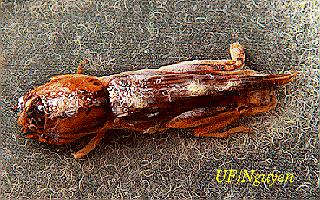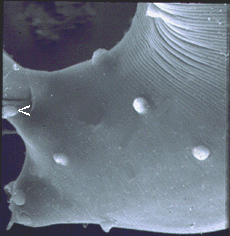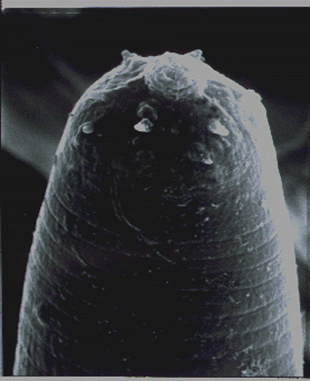Steinernema scapterisci
Nguyen & Smart, 1990

Steinernema scapterisci emerged from a mole cricket
DESCRIPTION
Males, first-generation
First generation male (FIG.1)much
smaller than first generation female, but anatomically the two are similar
anteriorly. Body usually plump. Head rounded continuous with body. Lips
not seen but 6 labial papillae prominent, and 4 cephalic papillae well
developed, much larger than cephalic papillae. Esophagus steinernematoid,
procorpus cylindrical, metacorpus slightly swollen, isthmus distinct, basal
bulb swollen with small valve. Nerve ring located in isthmus region of
esophagus but position variable. Excretory pore located anterior to mid-esophagus.
Excretory duct not forming elliptically-shaped structure present in females.
Posterior part of body curved ventrally. Body assumes a spiral shape when
killed by minimal heat. Gonad single, testis reflexed.Spicules (SEM)
averaging
83 micrometers long, dark brown in color, paired, uniformly curved, with
head large and somewhat angular. Angle formed by shaft and blade of
spicules averages 110 degrees (range 100-120). Shaft of spicules long
when compared to those of other species of the genus, and appears to be
encased in a sheath; blade tapers smoothly to end with posterior portion
thinner than that for other species of Steinernema. A small aperture
can be seen on ventral side close to tip of the blade.Each spicule has
two internal ribs with variable termination point proximally. Gubernaculum
boat-shaped, with anterior part thin, long and ventrally-curved. Spicules
glide along gubernaculum in two grooves separated by a needle-shaped cuneus.
Cloaca on a raised area bearing an anterior flap, seen easily when the
spicules are protracted or retracted. Eleven or 12 pairs and one single
genital papillae observed. One special pair located at the edge
of cloaca. Tail with a mucron. No phasmid observed.

Tail of a male showing a special pair
of genital papillae.
Measurements: Length=1728 um SD=358 (1319-2271); Width=156 um
SD=49 (97-231); EP=71 um SD=11 (63-98); NR=136 umSD=11 (120-152); ES=187
um SD=21 (164-216); testis flexure=374 um SD=52 (306-447); tail=25 um SD=3
(21-30); ABW=33 um SD=5 (31-45); mucron=4.3 um SD=0.6 (3.1-4.7); spicule
length=83 um SD=5 (72-92); spicule width=13 um SD=4 (13-14); gubernaculum
length=65 um SD=5 (59-75);gubernaculum width=8 SD=0.5 (8-9); D=36 SD=2
(32-39).
Abbreviations: um=micrometer; SD=standard deviation; EP=distance
from anterior end to excretory pore; NR=distance from anterior end to nerve
ring; ES=esophagus length; ABW=anal body width.
Males, second generation:Second
generation male similar morphologically to that of the first generation
except that it is about two-thirds as long and one-half as wide and the
spicules
have an elongate head.
Females,first generation
Anteriorly, female similar to male but much larger (FIG.2).
Lateral fields and phasmids not observed.Six labial papillae and four cephalic
papillae present. Stoma with prominent cheilorhabdions unusually thickened,
appearing as a circular or hexagonal ring in face view. Esophagus typical
of family. Esophago-intestinal valve large. Excretory pore located anteriorly
to mid-metacorpus.
Excretory duct unusually prominent forming an elliptically-shaped
structure seemingly with a hole at the center.Gonads didelphic, amphidelphic,
reflexed. Vulva appears as a transverse slit with a prominent double-flapped
epiptygma(FIG.21).Tail
length shorter than anal body width, with a mucron at end.
Females, second generation:
Second generation female similar morphologically to that of the first generation
with the following exceptions: about one-half as long and two-thirds as
wide, valve in basal bulb of esophagus more prominent, elliptically-shaped
structure less prominent, tail, which tapers to a point bearing a mucron,
longer than body width at anus.
Infective juvenile head showing
labial raising disc

Infective juveniles
( Third stage):The infective stage (FIG.3),
when newly formed, is always enclosed in the cuticle of the second-stage
juvenile as a sheath. However, the sheath is lost rather easily, even in
storage, and thus may not always be present. Body thin, head with a
labial raising disc; lip region not offset, oral aperture not observed;
six labial, four cephalic papillae and an elevated oral disc prominent.Esophagus
degenerate and thus not seen clearly, but its basal bulb is elongate and
has a valve. Lateral field with 6 incisures. Tail tapers gradually dorsally
but abruptly ventrally.
Measurements: L=572 um SD=27,(517-609); W=24 um SD=4,
(18-30); EP=39 um SD=4, (36-48); NR=97 um SD=1 (83-106); ES=127 um SD=6
(113-134); tail=54 um SD=3 (48-60)a=24 SD=2.7 (20-31); b=4.5 SD=0.2 (4.0-4.6);
c=10.7 SD=0.6 (9.2-11.7); D%=31 SD=3 (27-40); E=73 SD=6 (60-80)
TYPE HOST AND LOCALITY
The nematode found in the body cavity of the mole cricket, Scapteriscus
vicinus, Uruguay, South America.
DISTRIBUTION AND HOSTS
The nematode was originally found in Argentina, Brazil and Uruguay and
recently in the United States. It was reported to infect an killed insects
in the order Orthoptera: mole crickets of the genera Scapteriscus, Neocurtilla,
house cricket, Acheta domesticus, field cricket, Gryllus sp., Grass hopper
Romalea guttata; insects in the orders Coleoptera, Lepidoptera, Hymenoptera
are poor hosts or non-hosts (Nguyen & Smart 1991, 1995).

Steinernema scapterisci emerged from a cockroach
BIONOMICS AND HOST PARASITE RELATIONSHIPS
The nematode can survive and still be infective in the absence of hosts
for at least 10 weeks in moist soil (Nguyen & Smart 1990a).When infective
juveniles (IJ) of Steinernema scapterisci were released on the soil
surface in the field and in the laboratory, they moved downward through
the soil at least 10 cm in 5 days, infected and killed mole crickets (Nguyen
& Smart 1990b). When IJ were placed at the center of a 16-cm soil column,
they moved in both directions with three times more moving downward than
upward. In the field, nematode-infected mole crickets in the early stage
of infection spread the nematode during their flight (Smart et al. 1991).
Consequently, the nematode can be dispersed from inoculative field releases
on golf courses and pastures (Parkman et al. 1993a, 1993b). The IJ enter
the host through the mouth or spiracles (Nguyen & Smart, 1992).They
develop in the host in the same way as other species of Steinernema. If
the nematode number in a host is not overcrowded (nutrient supply is sufficient)
the IJ develop to males and females of the first generation. Most eggs
from these females hatch and the juveniles develop to become males and
females of the second generation. Eggs produced from these females develop
to IJ.This cycle takes 8-10 days. If the nematode number in a host is overcrowded
(nutrient supply is insufficient), they develop to males and females of
the first generation, and eggs produced by the females develop directly
to IJ, this cycle takes 6-7 days.This nematode can develop between 15-33
o C.
BACTERIAL ASSOCIATES
Bacteria from Steinernema scapterisci cultured in vivo, in vitro
and collected from fields were isolated and identified (Anguillera et al.
1993a).Many bacteria were associated with this nematode: Ochrobactrum
anthropi, Paracoccus denitrificans, Xanthomonas maltophilia, Xenorhabdus
bovienii, X. nematophilus, Xenorhabdus spp.These bacteria and three
others, Pseudomonas fluorescens, P. aureofacians,
and Escherichia coli were used for in vitro culture of this nematode.
The nematode developed normally and produced IJ with all studied bacteria
(Anguillera et al. 1993b).This fact shows that the nematode can feed on
different bacteria, consequently, the nematode survives very well under
field conditions.
BIOCONTROL CAPABILITY
Steinernema scapterisci is specific to mole crickets.The nematode was first
released in Alachua County, Florida, where it became established and spread
out to surrounding areas. Three years after the nematode was released,
a few mole crickets collected in a farm 10 miles from the nearest released
site were found infected with the nematode.By the fifth year, 25-65 % of
the mole crickets collected at this farm were infected (Smart et al. 1990).The
nematode was successfully introduced by inoculative applications in golf
courses and pastures (Parkman et al. 1993, 1994) in FloridaSince 1993 this
nematode has been commercialized in Florida to control mole crickets in
golf courses and pastures.
LITERATURE CITED
ANGUILLERA, M. M., & G. C. SMART, JR.(1992).
Bacterial symbionts of Steinernema scapterisci.Journal of Invertebrate
Pathology, 62:68-72.
ANGUILLERA, M. M., & G. C. SMART, JR.(1992).Development,
reproduction, and pathogenicity of Steinernema scapterisci in monoxenic
culture with different species of bacteria. Journal of Invertebrate Pathology,
62:289-294.
NGUYEN, K. B., & G. C. SMART, JR. (1992).Life
cycle of Steinernema scapterisci Nguyen & Smart, 1990. Journal of Nematology,
24:160-169.
NGUYEN,K. B., & G. C. SMART, JR. (1992).
Addendum to the morphology of Steinernema scapterisci. Journal of Nematology
,24:478-481.
NGUYEN, K. B., & G. C. SMART, JR. (1991a).Pathogenicity
of Steinernema scapterisci to selected invertebrates. Journal of Nematology,
23:7-11.
NGUYEN, K. B., & G. C. SMART, JR. (1991b).
Mode of entry and sites of development of Steinernema scapterisci. Journal
of Nematology, 23:267-268.
NGUYEN, K. B., & G. C. SMART, JR. (1990a).Preliminary
studies on survival of Steinernema scapterisci in soil. Soil and Crop Science
Society of Florida, Proceedings, 49:230-233.
NGUYEN, K. B., & G. C. SMART, JR. (1990b).
Vertical dispersal of Steinernema scapterisci. Journal of Nematology, 22:574-578.
NGUYEN, K. B., & G. C SMART, JR.(1990).Steinernema
scapterisci n. sp. (Steinernematidae: Nematoda). Journal of Nematology,
22:187-199.
PARKMAN, J. P., J. H. FRANK, K. B. NGUYEN, & G.
C. SMART, JR. (1994).Inoculative release of Steinernema scapterisci(Rhabditida:
Steinernematidae) to suppress pest mole crickets (Orthoptera: Gryllotalpidae)
of golf courses.Environmental Entomology, 23:1331-1337.
PARKMAN, J. P. J. H. FRANK, K. B. NGUYEN, & G.
C. SMART, JR. (1993).Dispersal of Steinernema
scapterisci (Rhabditida: Steinernematidae) after inoculative applications
for mole cricket (Orthoptera: Gryllotalpidae) control in pastures. Biological
Control, 3:226-232.
SMART,JR., G. C., & K. B. NGUYEN (1995).Biological
control of Orthoptera pest insects. United State Patent, patent number
5,466,448, date of patent: November, 14 1995.
SMART, G. C. JR.,K.B. NGUYEN, J. P. PARKMAN, &
J. H. FRANK (1990).Biological control of mole crickets in the
genus Scapteriscus with the nematode Steinernema scapterisci Nguyen &
Smart, 1990. Rencontres Caraibes en lutte biologique, Guadeloupe, 5-7 November
1990. Ed. INRA, Paris 1991.
[Beginning]
This document was constructed and is maintained by KHUONG
B. NGUYEN
Entomology & Nematology Department
University of Florida




